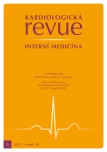Catheter ablation in atrial fibrillation and direct anticoagulants
Authors:
J. Špinar; R. Lábrová
Authors‘ workplace:
Interní kardiologická klinika LF MU a FN Brno
Published in:
Kardiol Rev Int Med 2017, 19(3): 183-186
Overview
Direct anticoagulants (blockers of factor II or factor Xa) have become a routine part of clinical practice and have replaced coumarine blockers (warfarin) in many indications, providing a more beneficial and safer effect. The main indications are non-valvular atrial fibrillation, deep venous thrombosis and lung embolism. New information are available in their uninterrupted use during catheter ablation of atrial fibrillation. The VENTURE AF study has shown non-inferiority of rivaroxaban vs. warfarin in 248 patients undergoing ablation of atrial fibrillation. The RE-CIRCUIT study compared the treatment with dabigatran and warfarin in 704 patients undergoing ablation of atrial fibrillation and has shown a superiority of dabigatran, especially in terms of its safety profile, as dabigatran treatment was associated with lower incidence of bleeding.
Keywords:
anticoagulation – atrial fibrillation – ablation – safety
Sources
1. Špinar J. Dabigatran v klinických studiích a reálném životě. Cor Vasa 2013; 55(5): 202– 206. doi: 10.1016/ j.crvasa.2013.04.006.
2. Špinar J, Vítovec J. Antikoagulační léčba fibrilace síní. Acta medicinae 2014; 9: 18– 23.
3. Špinar J, Vítovec J, Špinarová L et al. Rivaroxaban v léčbě fibrilace síní. Farmakoterapie 2013; 1: 6– 12.
4. Vítovec J, Špinar J. Antikoagulační léčba u srdečního selhání a hypertenze. In: Widimský J jr. Arteriální hypertenze – současné klinické trendy XIII. Praha: Triton 2016: 157– 162.
5. Špinar J, Vítovec J. Edoxaban v klinických studiích a v klinické praxi. Remedia 2016; 26(4): 348– 353.
6. Wazni OM, Marrouche NF, Martin DO et al. Radiofrequency ablation vs antiarrhythmic drugs as first-line treatment of symptomatic atrial fibrillation: a randomized trial. JAMA 2005; 293(21): 2634– 2640.
7. Hsu LF, Jais P, Sanders P et al. Catheter ablation for atrial fibrillation in congestive heart failure. N Engl J Med 2004; 351(23): 2373– 2383.
8. Arya A, Piorkowski C, Sommer P et al. Ablation of atrial fibrillation: patient selection, techniques, and the results. Herzschrittmacherther Elektrophysiol 2008; 19(2): 68– 72. doi: 10.1007/ s00399-008-0003-8.
9. Lábrová R, Špinar J. Katetrizační ablace fibrilace síní. Kardiologická revue 2008; 10(3): 103– 110.
10. Špinar J, Vítovec J, Špinarová L. Edoxaban v klinických studiích. Cor Vasa 2016; 58(6): 788– 496.
11. Heidbuchel H, Verhamme P, Alings M et al. Updated European Heart Rhythm Association Practical Guide on the use of non-vitamin K antagonist anticoagulants in patients with non-valvular atrial fibrillation. Europace 2015; 17(10): 1467– 1507. doi: 10.1093/ europace/ euv309.
12. Kirchov P, Benussi S, Dipak Kotecha D et al. 2016 ESC Guidelines for the management of atrial fibrillation developed in collaboration with EACTS. Eur Heart J 2016; 37(38): 2893– 2962. doi: 10.1093/ eurheartj/ ehw210.
13. Čihák R, Haman L, Táborský M. Doporučené postupy ESC 2016 pro léčbu fibrilace síní formulované ve spolupráci s EACTS. Cor Vasa 2016; 58: e636– e683. doi: 10.1016/ j.crvasa.2016.11.005
14. Cappato R, Marchlinski FE, Hohnloser SH et al. Uniterrupted rivaroxaban vs. uninterrupted vitamin K antagonist for catheter ablation in non-valvular atrial fibrillation. Eur Heart J 2015; 36(28): 1805– 1811. doi: 10.1093/ eurheartj/ ehv177.
15. Calkins H, Willems S, Gerstenfeld EP et al. Uninterrupted dabigatran versus warfarin for ablation in atrial fibrillation. NEJM 2017; 376(17): 1627– 1636. doi: 10.1056/ NEJMoa1701005.
16. Eikelboom JW, Walentin L, Conolly SJ et al. Risk of bleeding with 2 dosesof dabigatran compared with warfarin in older and younger patients with atrial fibrillation: an analysis of the randomised evaluation of long-term anticoagulation therapy (RE-LY) trial. Circulation 2011; 123(21): 2363– 2372. doi: 10.1161/ CIRCULATIONAHA.110.004747.
17. Larsen TB, Skjoth F, Nielsen PB et al. Comparative effectiveness and safety of non-vitamin K antagonist oral anticoagulans and warfarin in patients with atrial fibrillation: propensity weighted nationwide cohort study. BMJ 2016; 353: i3189. doi: 10.1136/ bmj.i3189.
Labels
Paediatric cardiology Internal medicine Cardiac surgery CardiologyArticle was published in
Cardiology Review

2017 Issue 3
Most read in this issue
- Cardiovascular risk stratification and new serum lipid target levels
- SGLT2 inhibitors (gliflozins) antidiabetics, antihypertensives or drugs for heart failure?
- Statin intolerance – finding practical solutions
- Infective Endocarditis
